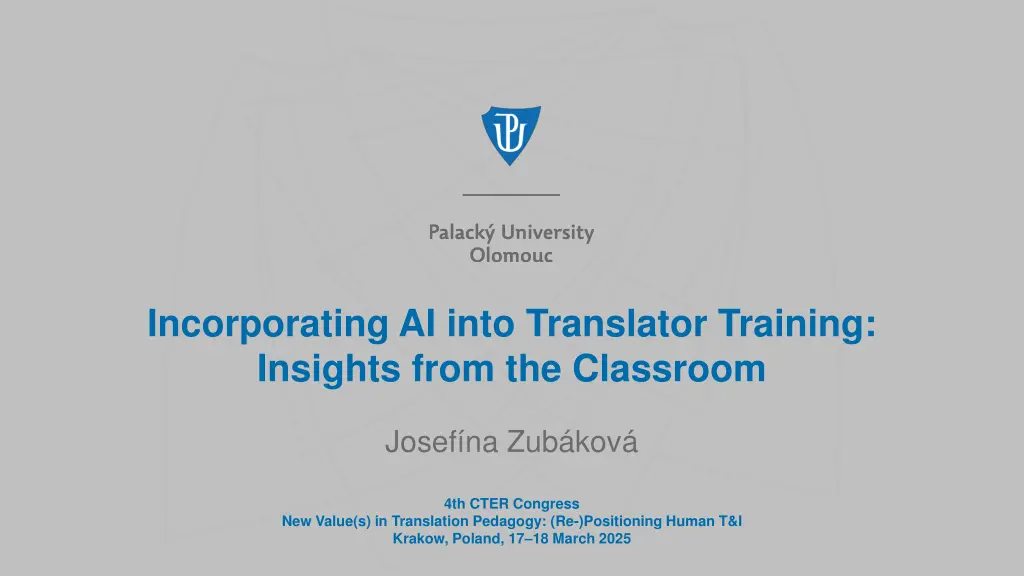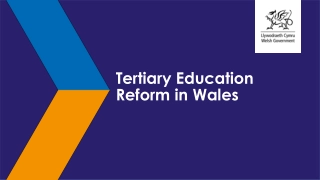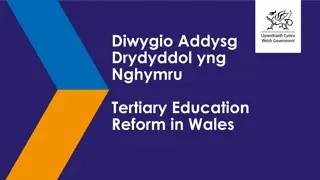
Insights into Incorporating AI in Translator Training
Explore how AI is integrated into translator training programs, focusing on the T&I Study Programme in Olomouc. This presentation outlines the curriculum, modules, and the balance between T&I subjects and complementary areas. Discover the theoretical, practical, and language competences developed to prepare graduates for future employment.
Download Presentation

Please find below an Image/Link to download the presentation.
The content on the website is provided AS IS for your information and personal use only. It may not be sold, licensed, or shared on other websites without obtaining consent from the author. If you encounter any issues during the download, it is possible that the publisher has removed the file from their server.
You are allowed to download the files provided on this website for personal or commercial use, subject to the condition that they are used lawfully. All files are the property of their respective owners.
The content on the website is provided AS IS for your information and personal use only. It may not be sold, licensed, or shared on other websites without obtaining consent from the author.
E N D
Presentation Transcript
Incorporating AI into Translator Training: Insights from the Classroom Josef na Zub kov 4th CTER Congress New Value(s) in Translation Pedagogy: (Re-)Positioning Human T&I Krakow, Poland, 17 18 March 2025
Presentation outline 1) Introduction of the study programme* 2) Introduction of the translation course 3) Incorporating AI into the introductory translation course 4) Learning outcomes * Hubscher-Davidson (2012)
T&I Study Programme in Olomouc English for Translation and Interpreting: T&I study programme at the Department of English and American Studies since 2005 reaccredited in 2023 as a career-oriented training BA programme focus on the practice and future employment of graduates 50 students enrolled in 1st year (WT 2023/2024) possibility to continue in a follow-up MA study programme
T&I Study Programme Modules Credits Subjects Theory and Methodology of Translation (2x), Translation T&P Exam, Theory and Methodology of Interpreting (2x), Interpreting T&P Exam, Contrastive Grammar for Translation (2x), Introduction to the Study of English Theoretical subjects 34 Translation Seminar (6x), Interpreting Seminar (6x) Profiling T&I subjects 48 Czech for Translators, Contrastive Lexicology and Phraseology, Terminology, Comprehensive Exam (English) Language competences 14 IT for Translators, Management of Digital Documents, CAT, Localization Technological competences 12 Translation Practice (3x), Interpreting Practice (3x) Professional practice 24 Phonetics for Interpreters, Corpus Linguistics, Literature for Translators, Practical Orthography, Legal English, Introduction to Pragmatics, Introduction to Stylistics, Internship Abroad Complementary subjects 24 Translation/Interpreting/Terminologyy/Localization Final project 15
T&I Study Programme Ratio of T&I subjects and other subjects 140 119 120 100 80 60 38 40 14 20 9 0 T&I subjects (theoretical, practical, practice) Complementary subjects Language competences C-subjects
T&I Study Programme Ratio of practical and theoretical T&I subjects 20 99 T&I practice (T&I practical seminars, practice, final project, technology) T&I theory
Graduate profile Graduates will be equipped with: research skills for quick orientation in new topics/fields universal skills widely applicable in the 21st century Graduates will demonstrate interest in current affairs, possess skills for critical thinking and intellectual curiosity. Graduates will be able to: create texts of various genres in both Czech and English; communicate professionally in both languages Graduates will have knowledge of information technology
Qs: At what stage in their education should students start using AI tools in translation classroom? Should novice translators be allowed to use AI or focus on producing their own (unaided) translations? How can students balance using AI tools with developing their own translation abilities? Should AI be integrated into translation programmes gradually or introduced in one dedicated course/module?
AI in the introductory course on translation Translation Seminar 1: introductory course - provides practical training in translation strategies and methods texts translated into L1 (from English to Czech) a wide range of texts and functional styles (popular-scientific, newspaper, publicist style, literary texts) parallel texts used to demonstrate the differences in functional styles in Czech and English students instructed to analyze in detail the ST and provide translations with regard to the target culture and TT user
Classroom activities and methods style analysis, ST analysis, translation/collaborative translation, revision, TT analysis, error spotting, error typology, translation quality assessment, translation commentary self-evaluation, self-reflexive questionnaire, peer-review, group- discussion, class-discussion, presentation, active participation student-centred communicative classroom (Colina 2003, 53)
AI and classroom activities pre-analysis of the ST (Nord 1991, Cragie and Pattison 2018): identifying translation challenges (rich points) production of unaided translation: students encouraged to produce their own translations without relying on AI tools self-reflexive questionnaire: students comment on rich points and their translation solutions AI-generated translation (students not limited in their choice of the tool) + post-editing questionnaire: students comment on their previous experience with AI and quality of AI-generated translation (comparison of unaided and AI-generated translation) group and class discussion on translation solutions, strengths and weaknesses of AI-generated translation
Puns, wordplays, cultural references, pragmatic aspect Violet had been thinking about Arthur Galbraith's face again, but she was yet to be convinced by any of the faces she had devised. None of them would do. She did not ask his opinion, for he had already shown himself to be difficult and ill-tempered when it came to making a choice. Her problem was further complicated by a small technical matter. Almost every element of his face had an 'e' in it somewhere and the 'e' on her borrowed turquoise blue Royal Quiet Deluxe typewriter often stuck. There was an 'e' in 'nose' and 'ear.' There were two in 'eye' and 'eyebrows' and cheeks' and 'teeth' and 'forehead.' It was infuriating. Every time she would have to press a small button and the top of the Royal Quiet Deluxe typewriter would pop open automatically, making the interior of the machine accessible. Then she would unstick the 'e', replace the top, press the backspace key and start again. Only Arthur's chin and mouth and lips were immune from the lengthy and annoying process. But they were not a place she cared to start. She knew something of chins and mouths, but a man's lips were unknown to her. She found herself thinking about them far more regularly than his nose. Did it matter what an imaginary explorer's lips looked like or felt like? She would never be kissed by such a man and 'kissed' had an 'e' in it.
Comments of students: 1) The most challenging part of the text was probably naming the different parts of the face to match the letter. I decided to use a different letter to make the effect the original text had clear to the reader. First, I translated all the words the author mentions and then found out which letter they had in common. As a result, I then had to rearrange their order a bit to make them logically fit the text. 2) Another problem was deciding whether to translate the name of the typewriter brand and whether to mention it again in the upcoming sentence. In the end, I decided to keep the name as I am of the opinion that in Czech it is common to keep it in the original wording. I did not use it again as English uses repetition more than Czech. 3) The third problem was to find a suitable equivalent for the expression "backspace" as I found it inappropriate to leave it in the original wording in the text, even though it is commonly used in Czech. Further options were: literal translation or "explanation" of the word. In the end I voted for the second option because it seemed less awkward.
WORDPLAY ChatGPT "e" in face parts: ChatGPT does not offer Czech translations (English expressions instead of Czech counterparts), after prompts ("e" to be replaced by "o" ) ChatGPT suggests face parts with "o", however, no logics used, non-sensical text Student comment: The letter "e" was the problem that AI couldn't handle at all. Even after a longer conversation and using more prompts it didn't come to a reasonable solution, rather it started to come up with even more stupid solutions and added words like "body" or "shoulders" to the description of the face.
WORD ORDER SYSTEMIC DIFFERENCES (NOMINAL vs VERBAL) (CONDENSATION) Student comments (-) The translation by AI is too literal with sometimes strange wording that sticks too closely to the source text. AI uses verbo-nominal constructions that should be translated verbally into Czech. I found many constructions in Czech version by AI too condensed and I tried to loosen them more in my own translation.
SYSTEMIC DIFFERENCES (GENDER) VOCABULARY VARIETY Student comments (+) I was surprised that the sentences were in the correct gender (feminine). AI has a broader database of words, so I appreciated its translation of adjectives and nouns. I would evaluate only some parts positively (e.g. " But they were not a place she cared to start ") as they are grammatically correct, make sense and sound natural. However, I would not rate most of the translated text positively.
Learning outcomes Ability to identify and analyze translation errors made by AI Critical evaluation of the causes of errors Reflection on errors and improving own translation skills
Colina, S. (2003). Translation Teaching. From Research to the Classroom. A Handbook for Teachers. Mc-Graw-Hill Higher Education. Cragie, S. and Pattison, A. (2018). Thinking Translation. New York: Routledge. Hubscher-Davidson, S. (2012). Curriculum Ideologies in Translator and Interpreter training. In Hubscher-Davidson, S. and Borodo, M. (Eds.) Global Trends in Translator and Interpreter Training. Mediation and Culture. London/New York: Continuum. Pp. 11-29. Nord, C. (1991). Text Analysis in Translation: Theory, Methodology, and Didactic Application of a Model for Translation-oriented Text Analysis. Amsterdam/New York: Rodopi.






















